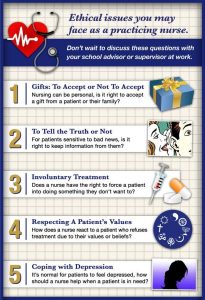Ethical dilemmas in nursing practice are a stark reality, presenting complex challenges that require careful consideration and navigation. Writing a case study on such dilemmas can be a powerful tool for reflection, learning, and ultimately, improving patient care.
This article will guide you through the process of crafting a compelling and insightful case study on ethical dilemmas in nursing, highlighting key considerations and offering practical tips for success.
Defining the Scope: Identifying Ethical Dilemmas in Nursing Practice
Before embarking on your case study, it's crucial to understand the vast landscape of ethical dilemmas nurses encounter daily. These dilemmas arise when conflicting values, principles, or obligations are present, forcing nurses to make difficult choices. Here are some common examples:
- Patient Autonomy vs. Beneficence: Balancing a patient's right to refuse treatment with the nurse's duty to provide beneficial care.
- Confidentiality vs. Disclosure: Maintaining patient privacy while considering the potential harm of concealing critical information.
- Resource Allocation: Deciding how to distribute limited resources, such as ventilators or medications, among multiple patients.
- Truth-Telling: Whether to disclose a terminal diagnosis to a patient who might not want to know.
- Professional Boundaries: Maintaining appropriate professional relationships while providing compassionate care.

Steps to Writing an Engaging Case Study on Ethical Dilemmas in Nursing Practice
Choosing the Right Case: Finding a Powerful Narrative
The foundation of a compelling case study lies in choosing a real-life scenario that effectively illustrates the complexities of ethical dilemmas in nursing practice. Here are some factors to consider:
- Relevance: Select a case that resonates with current nursing practice and addresses common ethical challenges.
- Impact: Choose a scenario that highlights the potential consequences of different decisions, underscoring the significance of ethical decision-making.
- Learnability: The case should provide opportunities for reflection and learning, offering practical insights for future nursing practice.
Constructing the Case Study: Building a Clear Narrative
Once you've chosen your case, it's time to craft a clear and concise narrative. Here's a step-by-step approach:
- Introduction: Briefly introduce the case, outlining the key players, setting, and the ethical dilemma at its core.
- Background: Provide essential details about the patient, their medical history, and the relevant circumstances surrounding the dilemma.
- Ethical Conflict: Clearly articulate the conflicting values, principles, or obligations that create the ethical dilemma.
- Decision-Making Process: Describe the steps taken to address the ethical dilemma, including any relevant ethical frameworks or guidelines consulted.
- Outcome: Explain the ultimate decision made and its consequences for the patient, the nurse, and the healthcare team.
- Reflection and Analysis: Examine the ethical implications of the chosen course of action, exploring the potential benefits and drawbacks.
- Learning Points: Identify key takeaways from the case study, suggesting strategies for future ethical decision-making in similar situations.
Integrating Ethical Frameworks: Guiding Principles for Decision-Making
To provide a robust framework for ethical decision-making, incorporate well-established ethical principles into your case study. These include:
- Beneficence: Acting in the best interests of the patient.
- Non-maleficence: Avoiding harm to the patient.
- Autonomy: Respecting the patient's right to make their own decisions.
- Justice: Ensuring fair and equitable treatment for all patients.
Utilizing Case Study Methodologies: Adding Depth and Insight
To enhance the depth and impact of your case study, consider incorporating various methodologies:

- Descriptive Case Study: Provide a detailed account of the ethical dilemma, focusing on the events and the decision-making process.
- Explanatory Case Study: Explore the underlying causes and contributing factors that led to the ethical dilemma, providing deeper insights into the complexities of the situation.
- Exploratory Case Study: Examine the ethical dilemma from multiple perspectives, including those of the patient, the nurse, and other healthcare professionals.
- Critical Case Study: Analyze the ethical dilemma through a critical lens, questioning existing assumptions and exploring alternative solutions.
Incorporating Relevant Ethical Theories: Examining Ethical Reasoning
Ethical theories offer valuable frameworks for analyzing and resolving ethical dilemmas. In your case study, consider incorporating relevant theories like:
- Utilitarianism: Emphasizing the greatest good for the greatest number of people.
- Deontology: Focusing on adhering to universal moral principles, regardless of consequences.
- Virtue Ethics: Highlighting the importance of developing good character traits, such as compassion and integrity.
- Feminist Ethics: Prioritizing the needs and experiences of marginalized groups, particularly women.
Writing with Clarity and Impact: Communicating Your Findings
A well-written case study should be clear, concise, and engaging. Here are some tips for crafting a powerful narrative:
- Use clear and concise language: Avoid jargon and technical terms, ensuring your case study is accessible to a wide audience.
- Adopt a neutral tone: Avoid expressing personal opinions or biases, presenting the case study objectively.
- Use headings and subheadings: Structure your case study logically, guiding the reader through the narrative.
- Include relevant visuals: Incorporate tables, charts, or images to enhance the understanding and impact of your case study.
- Use quotes: Include relevant quotes from the patient, the nurse, or other healthcare professionals to add authenticity and depth.
Engaging with the Literature: Building a Strong Foundation
To ensure your case study is grounded in existing knowledge and contributes to the body of literature, engage with relevant research and ethical guidelines.
- Review existing case studies: Learn from previous case studies on similar ethical dilemmas in nursing practice.
- Consult ethical guidelines: Refer to relevant professional codes of ethics, such as the ANA Code of Ethics for Nurses, to provide a framework for analysis.
- Review relevant literature: Identify and cite research articles, books, and other resources that address the ethical dilemma and its implications. Established academic writing platforms such as Nursing Papers offer well-articulated scholarly articles to help you with research.
Promoting Ethical Reflection and Development: Enhancing Nursing Practice

A well-constructed case study on ethical dilemmas in nursing practice can serve as a powerful tool for promoting ethical reflection and development. It can encourage nurses to:
- Consider the ethical implications of their actions: Foster critical thinking and decision-making skills.
- Develop their own ethical framework: Encourage the adoption of personal ethical principles and values.
- Engage in open dialogue and debate: Facilitate constructive conversations about ethical dilemmas and their impact on patient care.
Case Study Example: A Tangible Illustration
Imagine a case study about a patient refusing a blood transfusion due to religious beliefs, despite facing a life-threatening condition. The case study could explore the conflicting values of patient autonomy and the nurse's duty to preserve life. It could analyze the decision-making process, including discussions with the patient, family members, and other healthcare professionals. By incorporating ethical frameworks like beneficence and non-maleficence, the case study could highlight the complexities of this dilemma and provide insights into navigating similar situations.
Common Pitfalls in Case Study Writing
Case studies are powerful tools for demonstrating your academic journey, but they can easily fall short if you're not careful. Here are some common pitfalls to avoid:
- Lack of Clarity & Focus:
- Unclear objectives: What are you trying to prove with the case study? What is the central message you want to convey?
- No defined audience: Who are you writing this for? Are you targeting potential clients, investors, or internal stakeholders?
- Too broad of a scope: Trying to cover too much information can dilute the impact of your case study. Focus on a specific problem, solution, and outcome.
- Weak Story & Engagement:
- No compelling narrative: A case study should read like a story, not a technical document. Use engaging language and focus on the journey your client went through.
- Lack of human interest: Don't just focus on data and metrics. Highlight the people involved and their experiences.
- Too much technical jargon: Keep the language accessible to your target audience. Avoid using industry-specific terminology that they might not understand.
- Insufficient Data & Evidence:
- Weak or cherry-picked data: Don't rely solely on anecdotal evidence. Use hard data and metrics to back up your claims.
- Lack of context: Make sure the data is presented in a way that makes sense to the reader. Provide context and explanations.
- Missing key details: Don't leave out crucial information that might be relevant to the reader.
- Poor Structure & Formatting:
- Lack of clear headings and subheadings: Make the case study easy to read and navigate.
- Poor visual layout: Use visuals like charts, graphs, and images to make the information more engaging and understandable.
- No clear call to action: What do you want the reader to do after reading the case study?
- Ethical Concerns:
- Exaggerated results: Don't overstate the impact of your case study. Be transparent and honest about the outcomes.
- Lack of client permission: Always obtain written consent from the subject before publishing the case study.
- Confidentiality breaches: Be mindful of any sensitive information and avoid disclosing anything that could compromise the patient’s privacy.
Always seek feedback from your fellow learners and supervisor before publishing your case study. This can help you identify any areas that need improvement and ensure that your message is clear and compelling.
A Call for Ethical Awareness and Action
Writing a case study on ethical dilemmas in nursing practice is not just an academic exercise, it's a powerful tool for promoting ethical awareness, critical thinking, and positive change within the profession. By choosing impactful cases, crafting compelling narratives, and incorporating ethical frameworks and relevant theories, you can create a valuable resource for nurses and other healthcare professionals to learn from, reflect upon, and ultimately improve the quality of care provided to patients.

By consistently engaging with ethical dilemmas in nursing practice, through thoughtful analysis, discussion, and ongoing reflection, we can create a more just and compassionate healthcare system for all.
Professional Nursing Case Study Writing Assistance
Writing a case study on ethical dilemmas in nursing practice can be a challenging endeavor. However, there is no reason to worry because at
Academia Scholars, we offer professional nursing case study writing help. Our assistance covers all the stages of nursing case study writing including proof reading and editing, plagiarism check and removal. We can also help you with writing
nursing research papers, essays and
dissertations.


 A well-constructed case study on ethical dilemmas in nursing practice can serve as a powerful tool for promoting ethical reflection and development. It can encourage nurses to:
A well-constructed case study on ethical dilemmas in nursing practice can serve as a powerful tool for promoting ethical reflection and development. It can encourage nurses to:
 By consistently engaging with ethical dilemmas in nursing practice, through thoughtful analysis, discussion, and ongoing reflection, we can create a more just and compassionate healthcare system for all.
By consistently engaging with ethical dilemmas in nursing practice, through thoughtful analysis, discussion, and ongoing reflection, we can create a more just and compassionate healthcare system for all.